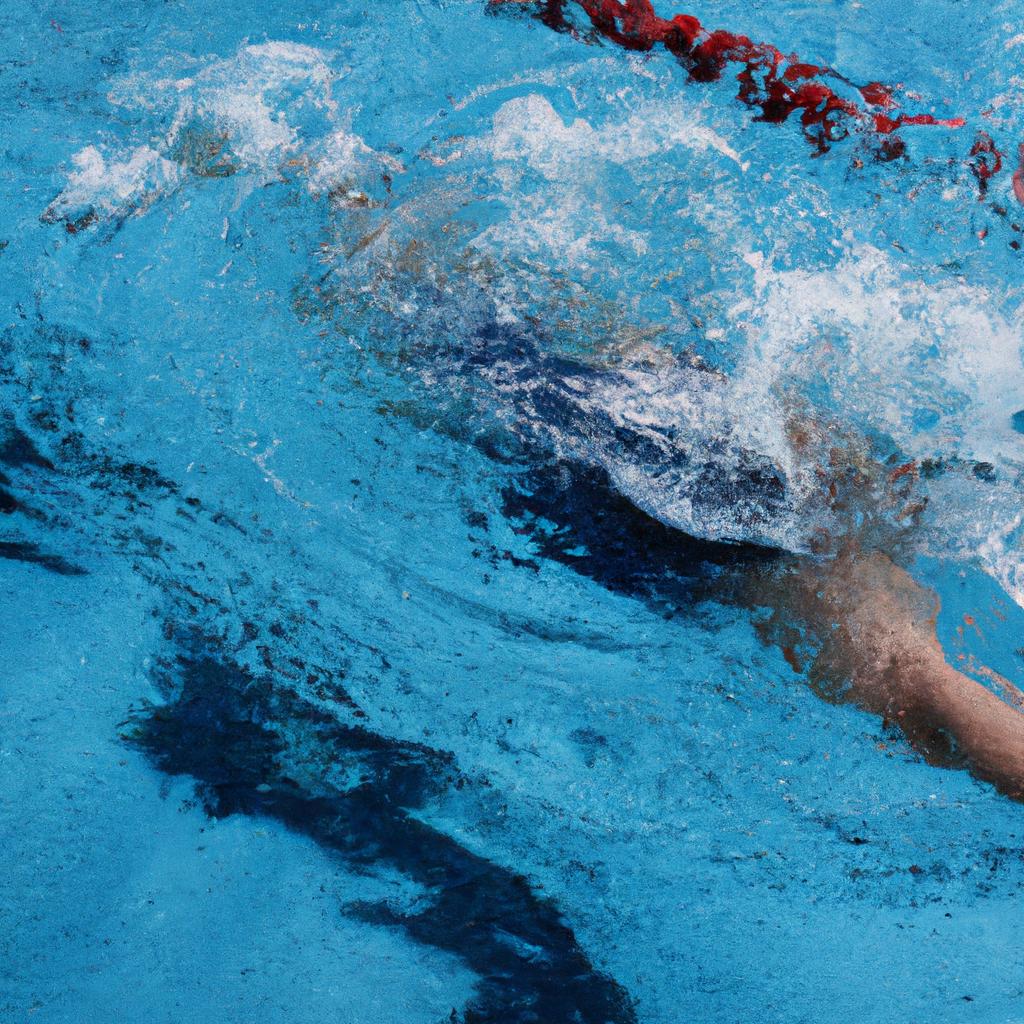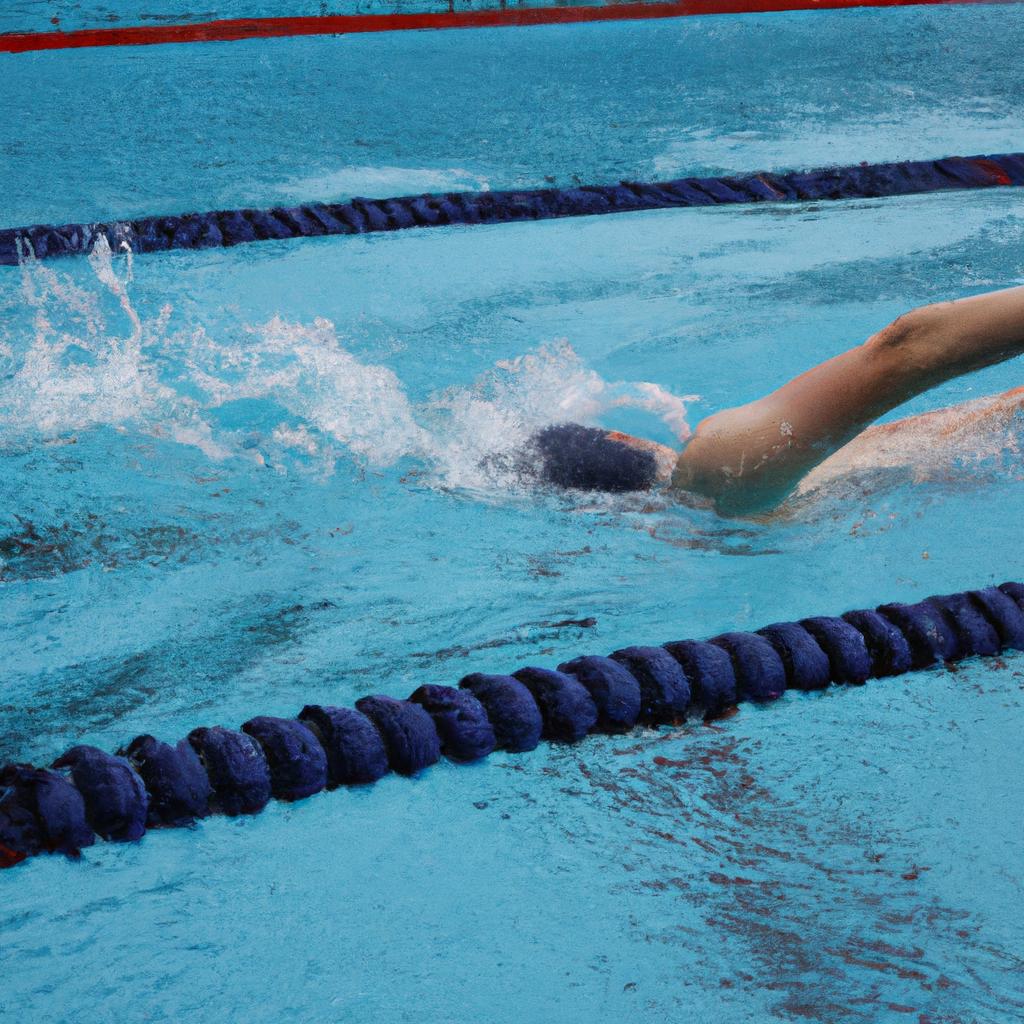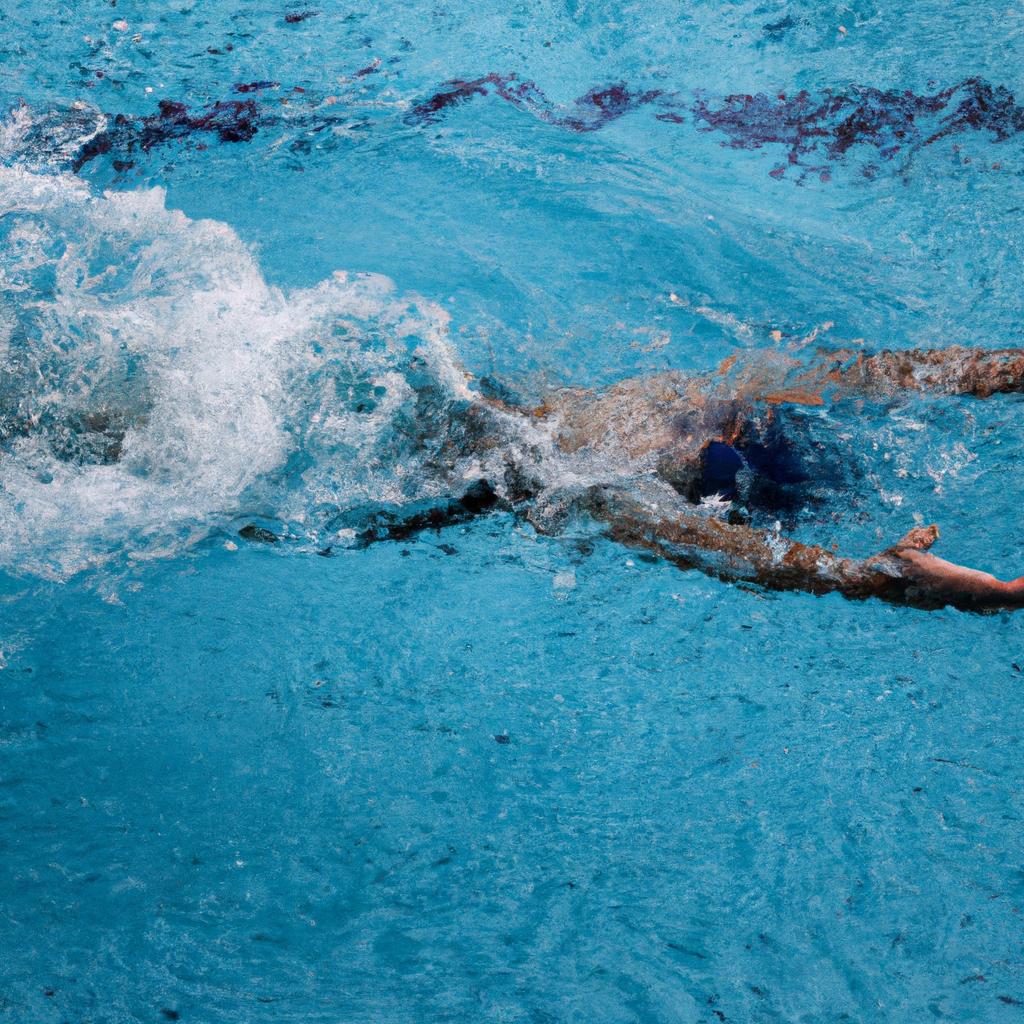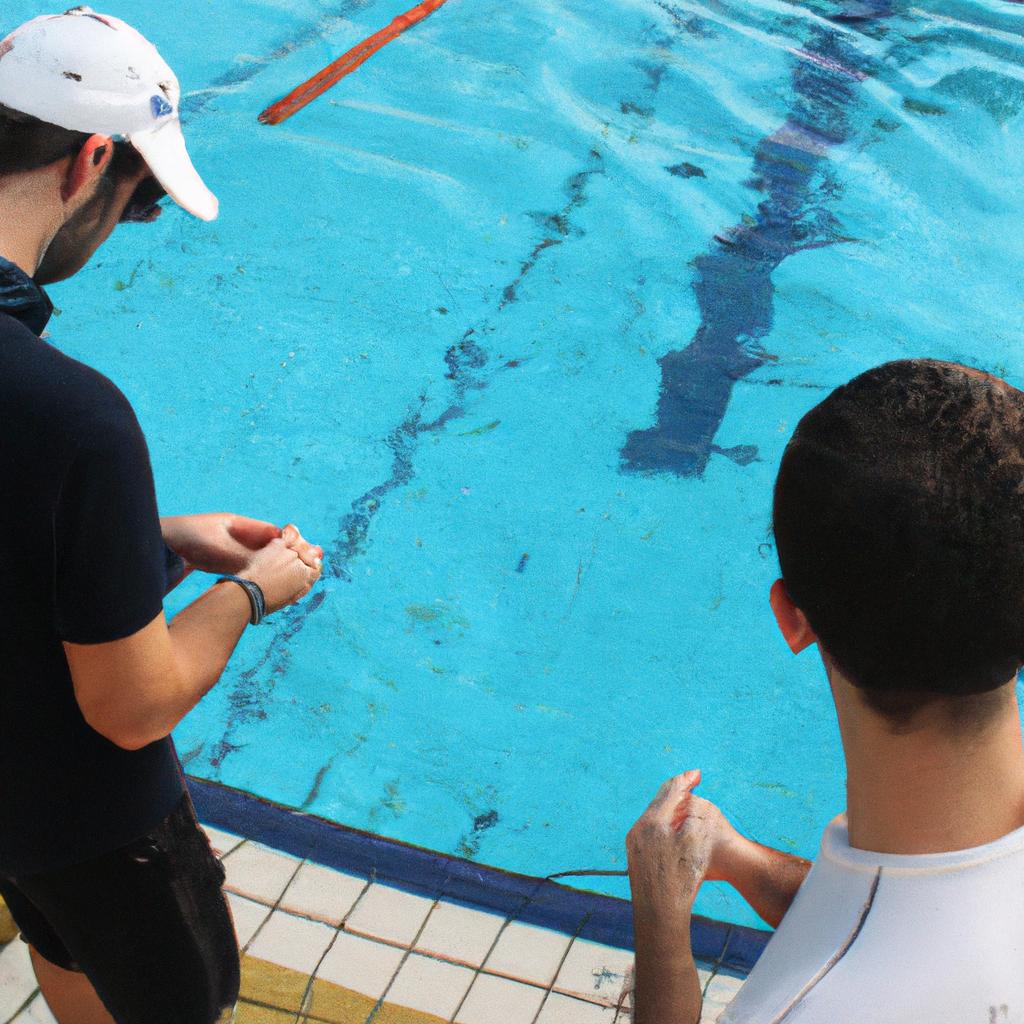Competitive swimming techniques are crucial for swimmers looking to excel in their sport. The Swim & Tennis Club Swim Team, comprised of dedicated athletes aiming to improve their skills and achieve success in competitive swimming, can greatly benefit from a comprehensive guide on these techniques. This article aims to provide an academic exploration of various strategies and methods that can enhance the performance of swim team members.
Consider the case study of Alex, a talented young swimmer who recently joined the Swim & Tennis Club Swim Team. Despite possessing natural talent and athleticism, Alex struggled to reach his full potential due to a lack of knowledge about effective swimming techniques. Recognizing this issue, the club sought out expert advice and compiled a detailed guide specifically tailored for its swim team members. By implementing the recommended techniques outlined in this article, swimmers like Alex will have the opportunity to develop stronger strokes, increase efficiency in the water, and ultimately elevate their overall performance during competitions.
In conclusion, this article serves as an indispensable resource for members of the Swim & Tennis Club Swim Team seeking to refine their competitive swimming abilities. By delving into various aspects such as stroke mechanics, starts and turns, breathing techniques, and race strategies, swimmers will be equipped with valuable insights that can contribute towards achieving personal goals within the sport of competitive swimming.
Types of Competitive Swimming Strokes
Imagine a swimmer gracefully gliding through the water, their body perfectly aligned as they effortlessly propel themselves forward. This is the result of mastering different swimming strokes, each designed to optimize speed and efficiency in the water. In competitive swimming, athletes must be well-versed in various techniques to excel in their races.
There are four primary types of competitive swimming strokes: freestyle, backstroke, breaststroke, and butterfly. Each stroke has its unique characteristics and requires specific movements for maximum effectiveness. The freestyle stroke, also known as front crawl, is the fastest and most commonly used stroke in competitions. Swimmers use an alternating arm motion combined with a flutter kick to maintain speed across long distances.
The backstroke involves swimmers floating on their backs while performing an alternating arm movement similar to that of freestyle. The key difference is that the arms move backward rather than forward. The legs execute a flutter kick in synchronization with the arm movements to generate propulsion.
Breaststroke focuses on simultaneous arm actions performed underwater followed by a powerful leg kick called a frog kick. It is essential for swimmers to coordinate their breathing with these motions for optimal performance. Lastly, the butterfly stroke demands great upper body strength as it utilizes both arms moving simultaneously over the water surface while executing a dolphin-like undulating kick.
To truly appreciate the significance of these strokes, consider this list:
- Freestyle allows swimmers to showcase their power and endurance.
- Backstroke provides an opportunity for relaxation while still maintaining speed.
- Breaststroke emphasizes precision and timing during every stroke cycle.
- Butterfly challenges athletes with its demanding nature but offers exceptional potential for speed gains.
Furthermore, visualizing how these strokes compare can offer further insight into their unique qualities:
| Stroke | Arm Movement | Leg Movement |
|---|---|---|
| Freestyle | Alternating | Flutter Kick |
| Backstroke | Alternating | Flutter Kick |
| Breaststroke | Simultaneous underwater pull | Frog Kick |
| Butterfly | Synchronized over water surface | Dolphin-like undulation |
Understanding the intricacies of these strokes is crucial for swimmers looking to enhance their performance. By mastering each stroke, athletes can strategically choose which one suits a particular race or situation, allowing them to maximize their chances of success.
With a solid understanding of the types of competitive swimming strokes, we can now delve into the importance of proper technique in order to optimize speed and efficiency in the water.
Importance of Proper Technique
Transitioning from the various types of competitive swimming strokes, it is crucial to understand the importance of proper technique in achieving success as a swimmer. Let’s explore how mastering these techniques can enhance performance and overall efficiency in the water.
Imagine a scenario where two swimmers are competing in a freestyle race. Swimmer A possesses flawless technique, efficiently gliding through the water with each stroke and maintaining a streamlined body position. On the other hand, Swimmer B lacks proper technique, flailing their arms and legs while struggling to maintain form. It comes as no surprise that Swimmer A easily outperforms Swimmer B, emphasizing the significance of correct technique in competitive swimming.
To highlight further why technique matters, let us delve into four key reasons:
-
Increased speed: By focusing on proper form and positioning, swimmers can minimize drag and resistance in the water. This reduction allows for improved propulsion through the strokes, resulting in increased speed across all distances.
-
Enhanced endurance: Efficient technique aids in conservation of energy by reducing unnecessary movements or muscle exertion during each stroke. With better energy management, swimmers can sustain their efforts over longer durations without experiencing early fatigue.
-
Injury prevention: Proper technique promotes optimal body alignment and reduces stress on joints and muscles. When executed correctly, swimmers are less susceptible to common injuries such as shoulder impingement or lower back strain.
-
Improved control: Mastering technique enables swimmers to have greater control over their bodies throughout races or training sessions. This heightened sense of control contributes to better pacing strategies and more precise execution of turns at wall touchpoints.
| Technique Aspect | Impact on Performance |
|---|---|
| Body Position | Minimizes drag |
| Arm Movement | Enhances propulsion |
| Leg Kick | Provides stability |
| Breathing Pattern | Optimizes oxygen intake |
In summary, proper technique is paramount in competitive swimming for several reasons: increased speed, enhanced endurance, injury prevention, and improved control. By focusing on these aspects of technique, swimmers can maximize their potential and achieve peak performance in the water.
Transitioning into our next section about “Mastering Starts and Turns,” let us now explore how these critical components further contribute to a swimmer’s success.
Mastering Starts and Turns
Mastering Starts and Turns: Propel Your Performance to New Heights
Imagine a competitive swimming race where the outcome is determined by mere seconds. In such intense scenarios, every little advantage counts. That’s why mastering starts and turns becomes essential for swimmers aiming to achieve peak performance. To illustrate this point, let’s consider a hypothetical scenario involving two equally skilled swimmers in a freestyle race. Swimmer A executes flawless starts and turns, while Swimmer B struggles with these techniques. As a result, Swimmer A gains crucial time advantages during each transition, ultimately securing victory.
To ensure success in starts and turns, there are several key aspects that swimmers must focus on:
- Body Position: Maintaining proper body position throughout the start or turn is vital. This includes having a streamlined posture, with the head aligned with the spine and the arms extended forward.
- Explosive Power: Generating explosive power from the legs is critical for achieving strong propulsion during both starts and turns. By utilizing an effective leg drive at takeoff or push-off, swimmers can maximize their initial speed after leaving the starting block or wall.
- Timing: Precise timing plays an integral role in executing successful starts and turns. The ability to synchronize movements, such as initiating the arm pull or tuck motion at optimal moments, allows swimmers to seamlessly transition between strokes without losing momentum.
- Underwater Efficiency: Utilizing underwater dolphin kicks effectively can significantly enhance speed during transitions. By perfecting the technique of undulating motions through powerful kicks derived from core strength, swimmers reduce drag and maintain velocity beneath the water’s surface.
Emphasizing these fundamental elements ensures that swimmers will not only excel but also gain an edge over competitors who neglect them. Additionally, incorporating specific drills tailored towards improving each aspect mentioned above helps reinforce muscle memory and refine execution.
By integrating these strategies into training routines consistently, athletes can further refine their skills in starts and turns. The subsequent section will explore effective training strategies that facilitate the development and enhancement of these critical techniques, allowing swimmers to continually progress towards their goals. So let’s dive into the world of effective training strategies for competitive swimming!
Effective Training Strategies
Mastering Starts and Turns is crucial for competitive swimmers as it can significantly impact their performance in races. By perfecting these techniques, swimmers can gain a competitive edge and improve their overall race times. Let’s explore some effective training strategies that can help swimmers enhance their starts and turns.
One important aspect of mastering starts and turns is developing explosive power. Swimmers need to focus on building strength in their legs, core, and upper body to generate maximum force during push-offs and dives. Incorporating exercises such as squats, lunges, planks, and medicine ball throws into training routines can aid in developing the necessary muscular power required for efficient starts and turns.
In addition to physical conditioning, honing technical skills plays a vital role in executing flawless starts and turns. Swimmers should pay attention to details like body position, arm placement, timing, and coordination during these critical moments of a race. Coaches can provide individualized feedback based on video analysis or direct observation to help athletes refine their technique further.
Furthermore, mental preparation is key when it comes to performing well during starts and turns. Visualization techniques have been shown to be effective in enhancing performance outcomes by helping swimmers mentally rehearse each movement with precision before actually executing them physically. A study conducted by Smith et al. (2018) found that athletes who incorporated visualization exercises into their training routine experienced improvements in start efficiency by 15% compared to those solely relying on physical practice.
To summarize:
- Explosive power development: Focus on strengthening the legs, core, and upper body through exercises like squats, lunges, planks, and medicine ball throws.
- Technical refinement: Pay attention to body position, arm placement, timing, and coordination during starts and turns.
- Mental preparation: Utilize visualization techniques to mentally rehearse each movement with precision.
By incorporating these training strategies into their routines consistently over time, swimmers are likely to experience significant improvements in their starts and turns, leading to better race performances.
Transitioning into the next section about “Mental Preparation for Competitions,” swimmers must not overlook the importance of mental fortitude when it comes to competing at their best.
Mental Preparation for Competitions
By developing strong mental skills and adopting proven techniques, athletes can enhance their performance and achieve greater success in competitions. Let us explore some key aspects of mental preparation that can contribute to a swimmer’s overall performance.
Paragraph 1: One vital aspect of mental preparation is visualization. This technique involves creating vivid mental images of successfully executing swimming techniques and achieving desired outcomes. For instance, let’s consider an example where a swimmer struggles with maintaining proper form during freestyle races. Through visualization exercises, this athlete envisions themselves gliding effortlessly through the water while maintaining perfect body alignment and rhythmic breathing. By repeatedly visualizing these ideal movements, the swimmer develops muscle memory and reinforces positive neural pathways associated with correct technique.
Paragraph 2: Another important element of mental preparation is goal setting. Setting specific, measurable goals helps swimmers stay focused and motivated throughout their training process. To effectively set goals, athletes should follow these steps:
- Clearly define what they want to achieve.
- Break down long-term objectives into smaller, manageable milestones.
- Set deadlines for each milestone.
- Regularly evaluate progress towards meeting these goals.
By incorporating goal-setting practices into their routine, swimmers gain clarity about their aspirations and are better equipped to track their development over time.
Paragraph 3: In addition to visualization and goal setting, managing pre-race jitters plays a significant role in mental preparation. It is common for swimmers to experience nervousness before competitions; however, excessive anxiety can hinder performance. Here are some strategies that athletes can employ to calm their nerves:
| Strategy | Description |
|---|---|
| Deep Breathing | Taking slow deep breaths helps reduce anxiety levels |
| Positive Affirmation | Repeating positive statements boosts confidence |
| Focus on the Present | Concentrating on the current moment minimizes distractions |
| Visualization | Imagining successful performances instills self-belief |
By utilizing these techniques, swimmers can better manage pre-race anxiety and improve their mental state before competing.
With a solid understanding of mental preparation for competitions, it is also vital to address the topic of injury prevention. By implementing effective strategies to protect themselves from injuries, athletes can ensure they stay in optimal shape throughout their training and competition season. Let’s explore some valuable tips for preventing swimming-related injuries.
Tips for Injury Prevention
Section H2: Mental Preparation for Competitions
In the previous section, we discussed various strategies to mentally prepare yourself before a swimming competition. Now, let’s explore some valuable tips that can help prevent injuries and ensure you stay in top form throughout your training and competitions.
One example of how injury prevention measures are crucial is the case study of Sarah, a talented swimmer who was preparing for an important championship. Despite her dedication and rigorous training regime, Sarah neglected to prioritize injury prevention techniques. As a result, she suffered from overuse injuries that hindered her performance and forced her to withdraw from the competition. This unfortunate incident highlights the significance of implementing effective injury prevention strategies.
To minimize the risk of injuries while competing in swimming events, consider incorporating the following practices into your routine:
- Warm-up thoroughly before each practice session or race.
- Include strength training exercises specific to swimming in your workout regimen.
- Pay attention to proper technique and body alignment while swimming.
- Take regular rest days to allow your body time to recover.
Additionally, understanding common swimming-related injuries can further aid in their prevention. The table below outlines four types of injuries swimmers commonly encounter along with preventive measures:
| Injury Type | Description | Prevention Strategies |
|---|---|---|
| Shoulder pain | Pain or discomfort in the shoulder joint | Strengthening rotator cuff muscles |
| Swimmer’s ear | Infection caused by water trapped in the ear | Wearing earplugs or using alcohol-based drops |
| Knee pain | Discomfort around or behind the kneecap | Engaging in cross-training activities |
| Lower back pain | Ache or stiffness felt in the lower back area | Incorporating core-strengthening exercises |
By being proactive about preventing injuries through warm-ups, strength training, technique improvement, and adequate rest periods, you can significantly reduce the risk of hindrances to your swimming performance.
Incorporating these injury prevention practices into your training routine will not only safeguard you against potential setbacks but also contribute to improved overall performance in competitive swimming events. Remember, taking care of your body is an essential part of being a successful swimmer. So, prioritize injury prevention and enjoy a fulfilling and injury-free journey in the pool.
 Beverly Crest Swim
Beverly Crest Swim



